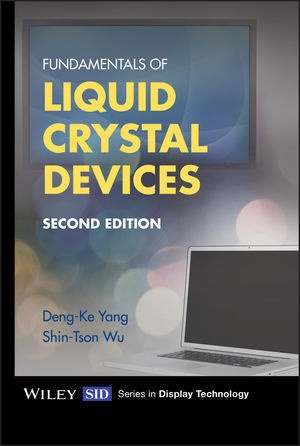Ulteriori informazioni
"Revised throughout to cover the latest developments in the fast moving area of display technology, this 2nd edition of Fundamentals of Liquid Crystal Devices, will continue to be a valuable resource for those wishing to understand the operation of liquid crystal displays. Significant updates include new material on display components, 3D LCDs and blue-phase displays which is one of the most promising new technologies within the field of displays and it is expected that this new LC-technology will reducethe response time and the number of optical components of LC-modules. Prof. Yang is a pioneer of blue-phase display technology and Prof. Wu has made significant contributions to the continuing advancement of the technology, and so are both undeniably well placed to offer an overview of this state-of-the-art technology"--
Sommario
Series Editor's Foreword xiii
Preface to the First Edition xv
Preface to the Second Edition xvii
1 Liquid Crystal Physics 1
1.1 Introduction 1
1.2 Thermodynamics and Statistical Physics 5
1.3 Orientational Order 10
1.4 Elastic Properties of Liquid Crystals 21
1.5 Response of Liquid Crystals to Electromagnetic Fields 27
1.6 Anchoring Effects of Nematic Liquid Crystal at Surfaces 38
1.7 Liquid crystal director elastic deformation 40
Homework Problems 48
References 49
2 Propagation of Light in Anisotropic Optical Media 51
2.1 Electromagnetic Wave 51
2.2 Polarization 54
2.3 Propagation of Light in Uniform Anisotropic Optical Media 59
2.4 Propagation of Light in Cholesteric Liquid Crystals 72
Homework Problems 85
References 86
3 Optical Modeling Methods 87
3.1 Jones Matrix Method 87
3.2 Mueller Matrix Method 98
3.3 Berreman 4 × 4 Method 113
Homework Problems 124
References 125
4 Effects of Electric Field on Liquid Crystals 127
4.1 Dielectric Interaction 127
4.2 Flexoelectric Effect 132
4.3 Ferroelectric Liquid Crystal 138
Homework Problems 146
References 147
5 Fréedericksz Transition 149
5.1 Calculus of Variation 149
5.2 Fréedericksz Transition: Statics 153
5.3 Measurement of Anchoring Strength 166
5.4 Measurement of Pretilt Angle 171
5.5 Fréedericksz Transition: Dynamics 175
Homework Problems 187
References 188
6 Liquid Crystal Materials 191
6.1 Introduction 191
6.2 Refractive Indices 192
6.3 Dielectric Constants 201
6.4 Rotational Viscosity 204
6.5 Elastic Constants 204
6.6 Figure-of-Merit (FoM) 205
6.7 Index Matching between Liquid Crystals and Polymers 206
Homework problems 210
References 210
7 Modeling Liquid Crystal Director Configuration 213
7.1 Electric Energy of Liquid Crystals 213
7.2 Modeling Electric Field 218
7.3 Simulation of Liquid Crystal Director Configuration 221
Homework Problems 232
References 232
8 Transmissive Liquid Crystal Displays 235
8.1 Introduction 235
8.2 Twisted Nematic (TN) Cells 236
8.3 In-Plane Switching Mode 241
8.4 Vertical Alignment Mode 263
8.5 Multi-Domain Vertical Alignment Cells 266
8.6 Optically Compensated Bend Cell 277
Homework Problems 281
References 283
9 Reflective and Transflective Liquid Crystal Displays 285
9.1 Introduction 285
9.2 Reflective Liquid Crystal Displays 286
9.3 Transflector 290
9.4 Classification of Transflective LCDs 293
9.5 Dual-Cell-Gap Transflective LCDs 312
9.6 Single-Cell-Gap Transflective LCDs 314
9.7 Performance of Transflective LCDs 314
Homework Problems 316
References 316
10 Liquid Crystal Display Matrices, Drive Schemes and Bistable Displays 321
10.1 Segmented Displays 321
10.2 Passive Matrix Displays and Drive Scheme 322
10.3 Active Matrix Displays 326
10.4 Bistable Ferroelectric LCD and Drive Scheme 330
10.5 Bistable Nematic Displays 332
10.6 Bistable Cholesteric Reflective Display 342
Homework Problems 358
References 359
11 Liquid Crystal/Polymer Composites 363
11.1 Introdu
Info autore
Deng-Ke Yang Liquid Crystal Institute, Kent State University, USA
Shin-Tson Wu College of Optics and Photonics, University of Central Florida, USA
Riassunto
Liquid Crystal Devices are crucial and ubiquitous components of an ever-increasing number of technologies. They are used in everything from cellular phones, eBook readers, GPS devices, computer monitors and automotive displays to projectors and TVs, to name but a few.

